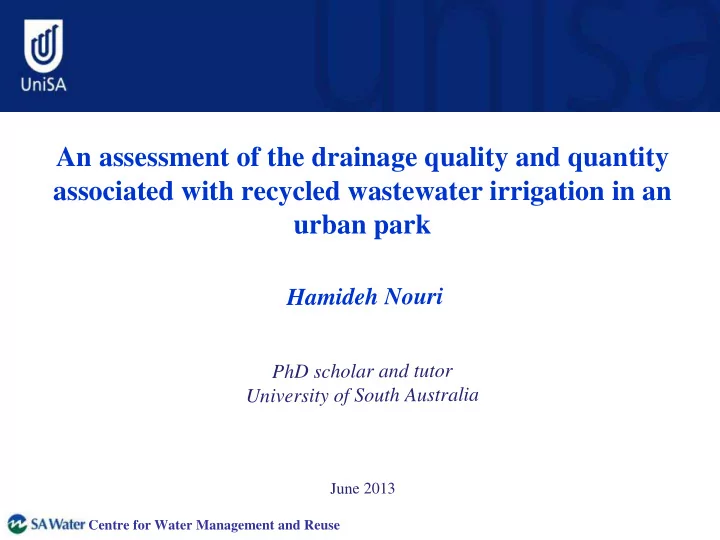

An assessment of the drainage quality and quantity associated with recycled wastewater irrigation in an urban park a m i d e h N o u r i H PhD scholar and tutor University of South Australia June 2013 Centre for Water Management and Reuse
Background � Of some concern is the nutrient leaching nutrient leaching from drainage into ground water that possibly percolates excess nutrient to the ground water table. This is even more critical when reclaimed wastewater throughout irrigation. Centre for Water Management and Reuse
Soil Water Balance (SWB) A soil moisture budget tracks the inputs and outputs of water in soil . Drainage Drainage (deep percolation) (deep percolation) Centre for Water Management and Reuse
Knowledge gap � Research work on Soil Water Balance of agricultural crops is well established. � Little research has been conducted on this aspect for urban green space mixed plantings. Centre for Water Management and Reuse
Drainage, a component of SWB Estimating drainage requires in-situ soil water collection from undisturbed soil which is quite challenging particularly in heterogeneous urban landscape environments . Centre for Water Management and Reuse
Why pan lysimeter? Pan lysimeter is a sampler in a pan shape, without large side walls, that freely collects the drained water, measuring drainage volume and solute leaching simultaneously. ADVANTAGES: •low complexity design •inexpensive to construct and install •reduced disturbance of the soil in installation •simple and cheap operation •minimizes the surrounding matric potential fl uctuations and potential bypass fl ow Centre for Water Management and Reuse
Lysimeter installation Centre for Water Management and Reuse
Objective Study the temporal variation of drainage rate and nutrient leachingin an urban park Map of the urban park and lysimeter position Centre for Water Management and Reuse
ο C ο ° C Study area ° Centre for Water Management and Reuse
Quantity of drainage • The volume of the drained water was recorded monthly and analysed. Summer Winter Irrigation 198.67 0 Rainfall 37.44 157.36 236.11 157.36 Input water (irrigation + rainfall) Volume of drainage 0.8 123.6 Centre for Water Management and Reuse
Quality of drainage Comparison of leachate solute (ppm) from summer to winter Ionic Balance Total Phosphorus as P (*10) Total Kjeldahl Nitrogen as N (*10) Nitrate as N (*100) Winter Nitrite as N (*100) Potassium (*0.1) Summer EC Sodium Absorption Ratio (*0.1) pH Value 0 2 4 6 8 10 12 Centre for Water Management and Reuse
Outcomes & benefits The risk of nutrient loading resulting from irrigation with recycled waste water was investigated. The outcomes showed a minimal impact from use of recycled waste water in terms of nutrient loading to the ground water for the study period . Centre for Water Management and Reuse
Thank y ou f or t he k i nd at t ent i on Thank you for your kind attention Centre for Water Management and Reuse
Recommend
More recommend